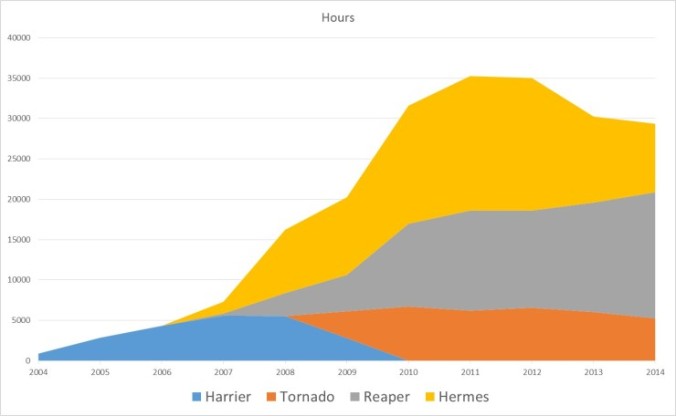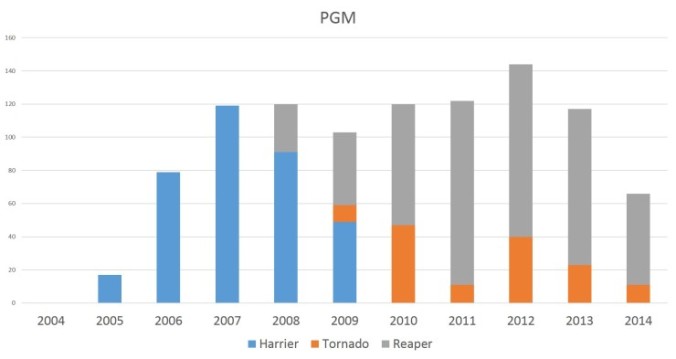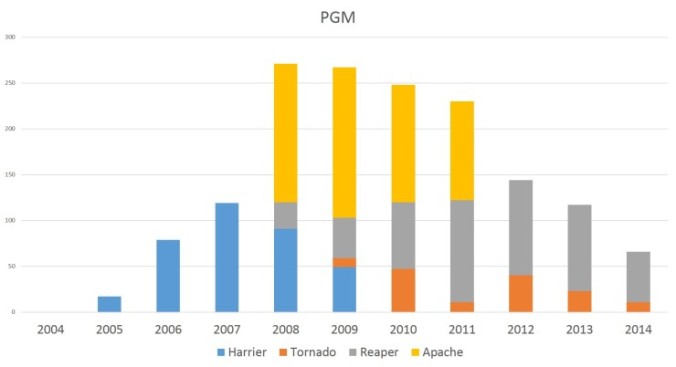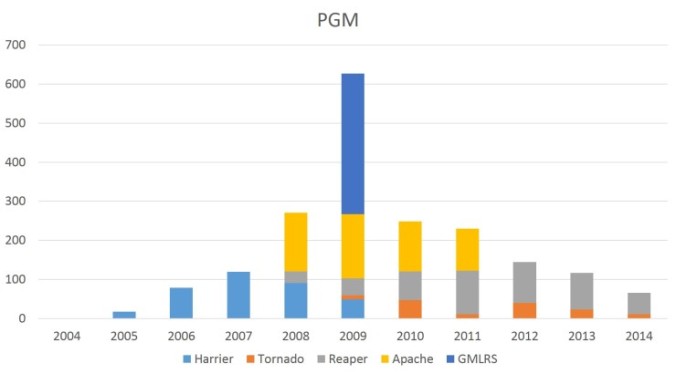Defence Statistics and the Air Warfare Centre released a statistics bulletin covering Aircraft sorties, hours and weapons released for Operation HERRICK, Afghanistan.
It makes for some fascinating reading but it is worth repeating pointing to Page 16 before starting, the section on making like for like comparisons or drawing conclusions from bare data.
So, click here to read, but skip to Page 16 first.
The key points and trends, quoting from the report, are;
Flying Hours
- Harriers were used in Afghanistan from 2004 to 2009, when they were withdrawn from service and replaced by Tornados, which were used up to the end of Op HERRICK. Harrier and Tornado flew more than 56,000 hours in total, averaging about 500 hours per month between 2007 and 2013.
- Reaper was introduced in Afghanistan in 2007. Unlike Harrier and Tornado, Reaper is remotely piloted and is primarily tasked in an Intelligence, Surveillance and Reconnaissance role, but also has an armed capability. Reaper’s annual flying hours steadily increased between its introduction in 2007 and 2011, due to a staged increase in Reaper platforms arriving in Theatre and the subsequent increase in missions flown. Reaper flew more than 71,000 hours in total, averaging just over 1,000 hours per month in 2011 and 2012. This increased in 2013 and 2014.
- All the Unmanned Aircraft Systems operated by the British Army are unarmed. Hermes aircraft flew over 85,000 hours in Afghanistan in total, and the Desert Hawks more than 18,000 hours.
Weapons Expended
- To obtain a fair measure of weapon usage frequency, which accounts for the different types of weapon available to each aircraft, each mission report received from Theatre is retrospectively examined to determine the number of Weapon Release Events (WREs) during that mission. The number and frequency of WREs peaked in 2006. After 2006, there were downward trends in the numbers and frequencies, which were not significantly altered by the switch from Harrier to Tornado, or the introduction of Reaper. The overall WRE rate was highest for Harrier, followed by Reaper, then Tornado.
- Comparing only precision-guided munitions (PGM), and ignoring all the use of unguided weapons by Harrier and Tornado, the total number PGM used by RAF fixed-wing aircraft each year did not substantially change with the introduction of Reaper: Harrier was the only RAF fixed-wing aircraft which expended PGM until 2007, and in 2007 it expended 119. From 2008, PGM were also expended by Tornado and Reaper, and the average from 2008 to 2013 was 121 per year.
- The overall rate of PGM expended was highest for Harrier, followed by Reaper, then Tornado.
To which I would also add;
- The data does not include 27mm on Tornado, or 30mm on Apache,
- No CRV-7 for Apache or Harrier,
- No show of presence/show of force data,
- Sorties would not all be for British forces given the large area of operations and multinational nature of the air campaign,
- Different missions would be needed for different areas,
- The ‘surge’ and initial operations that heavily relied on close air support are not specifically mentioned,
- No differentiation between Close Air Support and deliberate strikes or interdiction missions,
- No mention of changing rules of engagement,
- No indication of when USMC support assets were available.
So with all the caveats and warnings it is difficult to draw any conclusions but it is clear that the hours flown between Harrier and Tornado remained relatively stable throughout the entire campaign, from a much smaller Harrier fleet, this is impressive. Hours flown by Hermes 450 and Reaper were vastly more than Harrier or Tornado, entirely as one might expect.
Where the graphs and data tables in the report don’t do, is present the Army and RAF data together. The report makes it clear that it has been unable to obtain reliable data for Apache Hellfire expenditure and hours/sorties. There has, however, been some data released through Parliamentary Answers, it is fragmentary and incomplete but assuming it is relatively accurate, does allow a handful of point comparisons to be made.
Merging the data shows the hours flown between Harrier (until it was withdrawn), Tornado, Reaper and the leased Hermes 450’s.

Watchkeeper managed 60 hours in 2014 but not included in the graph.
The Hermes 450 is air vehicle base design as Watchkeeper but the amount of hours flown by it compared to even Reaper is dramatic. As combat operations started reducing in 2012 its hours reduced whilst Reaper increased slightly, the changing nature of operations I guess. This chimes with a number of comments that Hermes provided the majority of tactical ISTAR for operations.
The second series of graphs below shows precision guided weapons released by each aircraft type.

The data and report do not show Hellfire missiles fired by Apache attack helicopters. Add in the 4 years of data from PQ’s and it shows for those years where data is available, Hellfire from Apache was much more common than fast jet or RPAS released weapons.

With GMLRS being increasingly used I thought I would add in usage for that as well. Unfortunately, only 1 year of data is available from PQ’s the first full year it was used, 2009.

No additional GMLRS data is available in Hansard but if anyone has anything to add to these, I will update the table and graph.
It would seem that for operations in Afghanistan, once Apache and GMLRS were in theatre, the Army expended the vast majority of precision guided weapons and RPAS flying hours in support of the ISTAR requirement.
Interesting.
There is also a curious statement about the sharp decrease in PGM release by Tornado in 2011, explained by ‘a focus on operations in Libya’
Does this mean we didn’t have enough stock of Dual Mode Brimstone and Paveway IV for simultaneous operations in two theatres and had to prioritise one over the other?
The hours flown remained fairly steady in this period and given that air support was an ISAF, not national, responsibility others would have picked up the gap..
Clearly, munition availability was an issue.
H/T HMAF
What do the highlights tells us?
1. We use the correct aircraft for the correct mission when a choice is available.
2. During harrier only ops no choice was available.
3. No point in launching an aircraft when you can fire a ground based system.
4. We never stopped one operation to support another, that’s a nonsense statement without evidence of calls for fire being either delayed or unanswered. what obviously did happen is that when there was an option to preserve Tornado munitions and utilise another platform in order to to minimise impact against what at the time was an unknown expenditure level in Libya, that decision was taken. Sound military judgement.
Basically nothing surprising then.
LikeLike
Echoing APATS comment, but its interesting to note the sheer number of GMLRS in that single year… are you sure that’s correct TD?
LikeLike
Mike, it was from a PQ but let me double check.
APATS, fair comment, it was poorly worded, I suspect we relied upon others but the point remains, our stock levels of PGM’s could not support simultaneous operations
Not arguing that it wasn’t sound judgement to balance one against the other but the fact that we had to is rather worrisome. Look at the numbers, we were supporting about 40 per year (DM Brimstone and PVIV), that is not even 4 a month.
4 a month and we had to ‘prioritise’
Good job we weren’t trying to knock out a Russian armoured division!
Expect the high rate for Harrier was as explained, nothing else available, but also because we deployed with the platoon house strategy and then had to bomb our way out.
What I find interesting is that the Army provided most of the ISTAR and PGM expenditure, even if the GMLRS number is incorrect
LikeLike
Mike, just checked, 360 expended in 2010, Jan to Nov, Dec not included in data, so final number potentially, slightly higher
The PQ ould be wrong of course, it does make reference to rounding to 5 and might be reflective of quantities purchased but would that seem 360 go down to 40, probably not
http://www.theyworkforyou.com/wrans/?id=2010-01-05e.306745.h&s=gmlrs#g306745.r0
LikeLike
What would be interesting to know is how many GMLRS rockets were fired per mission, in comparison to other PGM. A UAV or FJ is going to fire 1 generally knowing it can have eyes on the result and an immediate re engagement as required. Given the “relative” cheapness of GMLRS was there perhaps a bias towards salvo fire?
Just teasing out how my operator head sees stats.
In terms of the Army supplying ISTAR and PGMs; good, in an uncontested air environment where the OPFOR has zero counter battery capability it is satisfying to see the capability demonstrated. With a CAPDEV head on it was also an ideal occasion for the army to prove some new systems. The RAF and FAA are used to providing ISTAR, Strike and CAS, this was a great chance for the Army to utilise their new capabilities, glad that they did.
Once again, it all echoes sound military decision making to me.
LikeLike
Reinforces the old rule that the biggest killer on the battlefield is Artillery (true in E Ukraine now). And the RA took responsibility to do their own ISTAR with Hermes/Watchkeeper.
I guess it shows there’s a penalty for putting a man in the air. RA have found a way not to have to.
What the RAF brings is air superiority to allow RPAS and UAS to be able to operate. Not relevant in Afghanistan: but very relevant in Poland or the Baltics.
LikeLike
So does it me, not sure where I said any of this was a bad thing, just the stocks of PGM. It is interesting that the bulk of PGM expenditure and unmanned ISTAR is green, not blue, but interesting means just that and no more
With these stats there are always more questions, always 🙂
LikeLike
The army flew Hermes uavs or contractors flew Hermes uav?
LikeLike
ut of reach of artillery and the ability to engage OPFOR artillery.
Like most Military solutions it is not about trumpeting single service or environment solutions it is about how they compliment each other, especially when faced with a peer enemy.
it is equally important to learn limitations as it is capabilities.
By that I mean that DLIs should have been raise based on utilising blue forces to track and monitor UAS to prove caps and lims.
LikeLike
Fair one Mark, I think contractors took off and landed, then mid-flight stuff by the RA
LikeLike
Weren’t most of the contractor’s personnel ex- Tornado aircrew?
LikeLike
So they flew quite a lot, a yearly average for similar planes would be 250, so on that leisurely basis we would have had 24 planes there every year (less in reality?).
– cfr. I don’t know what is impressive about the following statistic, because the a/c were maintained in the field, as opposed to the Apaches that were rotated, so other than coming up against harmony rule limits for pilots (of the smaller community?), what is the constraint where a “stretch” was achieved? “the hours flown between Harrier and Tornado remained relatively stable throughout the entire campaign, from a much smaller Harrier fleet, this is impressive.”
Might be a spurious conclusion from this “The overall WRE rate was highest for Harrier, followed by Reaper, then Tornado” but the Tornados always got there too late? (Should be adjusted for their late coming in and the heightened concern by and within ISAF for collateral damage as the campaign drew on.)
Excellent article ( making the best use of available statistics and also making the caveats clear). If the conclusion was that army assets did the heavy lifting and fast jets were there just to look relevant, I would probably concur.
LikeLike
ACC, yes, I was thinking of it from a ground and aircrew perspective
LikeLike
“If the conclusion was that army assets did the heavy lifting and fast jets were there just to look relevant, I would probably concur.”
except it was by no manner of means the conclusion, nor would it be correct.
i do not know why so may posters on here look at drawing exaggerated and incorrect conclusions from raw data but there is no escaping the fact that they are generally the posters without the background to properly evaluate the raw stas.
Just an observation.
there are lies, damn lies and statistics. incorrect, there are lies, damn lies and statistics not properly interpreted.
LikeLike
APATS, I agree
” there is no escaping the fact that they are generally the posters without the background to properly evaluate the raw stas.
Just an observation.
there are lies, damn lies and statistics. incorrect, there are lies, damn lies and statistics not properly interpreted.”
So step forward, the floor is yours! (for the right conclusions…)
LikeLike
Heh-heh… I forgot to mention that I have a degree in statistics… but that has nothing to do with this topic
(It is “required reading” – even though not to a degree level – for economists, so no doubt SO will come forward with a “me too”!)
LikeLike
Read my previous posts. ref the benefit of utilising and proving the Armys new kit in a benign environment. the fact that this is a bloody good thing to have done. That we should fully take advantage of this by identifying capabilities and limitations.
That we made full use of the appropriate assets ion terms of cost effectiveness and also to minimise use of PGM that were at a certain time crucial in Libya but replaceable in Afghanistan.
That it allowed the capability development of new effects in one service and minimised wear and tear on very expensive assets that we already knew could do the job.
that there was potentially an overkill use of indirect non line of sight munitions due to lack of eyes on and ability to re engage a target immediately.
That no account of the numerous use of air assets in the deterrent mode was taken account of.
That the nature of the conflict, areas controlled and ability to support these areas from within indirect ground fire support changed.
The correct conclusion is that a tri service mission utilised the correct assets in support of UK ground forces in Afghanistan taking account of the changing shape and nature of the conflict and available assets as well as other strains on resources. This was done whilst maximising combat capability development and integration of fresh into service enablers.
Nothing controversial because there was nothing controversial about it. You were the one who tried to come up with a controversial conclusion, funny that.
You posted this in response to SO the other day ” I actually wrote an opening speech for one of the IMF/ World Bank Annual Meetings, so academics or otherwise, I may understand it a bit better than you (call a friend… if you know what I am alluding to).”
You also posted in the same post “you wrote some BS that squarely puts you in the locker that HH has been ascribing for you ( and this is just the straw that broke the camel’s back”
You have in the past accused me of being a government plant as well.
Now i do not know why an economist would want to hang around a military forum trying to make pretty mundane business seem sensationalist with conclusions that are wildly off target. i certainly do not hang around any economics forums.
However please do not be surprised when I take as much offence to your conclusions as you would to me trying to lecture you on why we should really have cut interest rates. Though I would probably try and be less sensationalist.
LikeLike
May I point out that economics is statistics and not always about the World Bank/IMF?
LikeLike
Yes, this is a discussion forum, thanks for extra points of view. RE
“Nothing controversial because there was nothing controversial about it. You were the one who tried to come up with a controversial conclusion, funny that.”
Funny this one, too “May I point out that economics is statistics “. You probably meant econometrics, one branch of economics but a fairly specialised one. Statistics is one leg that economics stands on, but economics is not statistics.
– lots of books,even a dictionary would resolve the “dilemma”
End of lecture… have fun
LikeLike
@ACC
It is traditional to identify the person you respond too. Your second point ref economics was directed at HMARFR not me. It also makes my point for me, his post about economics brought a response from you as an SME. Well yours are often at the same sort of level in our field and funnily enough bring about a response from defence SMEs.
LikeLike
There are (at least) two potential problems with statistics – poor interpretation is one but intended or unintended bias in the data gathering is the other. Thus the raw numbers can be rubbish before any interpretation starts. This is less likely in simple counting and recording as we have here but is frequently an issue in observational and sampling data collection; and is why I rarely give much credence to either political party that quotes statistics to support their arguments e.g. on things such as A&E waiting times without evidence of unbiased data collection
LikeLike
“Now i do not know why an economist would want to hang around a military forum”
Is that to say that only military types should hang around on a military forum? Agreeing with each other?
How boring.
LikeLike
I was typing too fast.
Let’s get back to the military shall we?
LikeLike
Why didn’t the Apache have CRV7? Were they frightened of collateral damage?
LikeLike
That is an awful lot of GMLRS. Most engagements seem to be 1 or 2.
I’ve always wondered what the occasion was for this though…strewth…
LikeLike